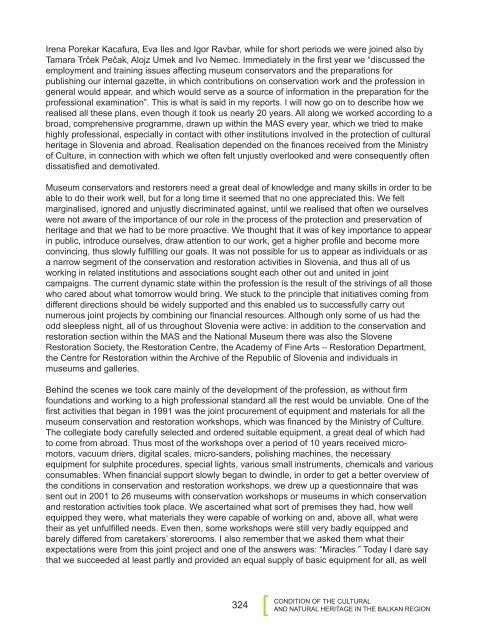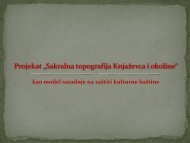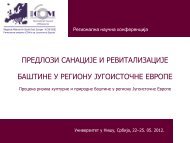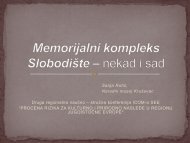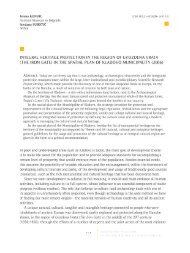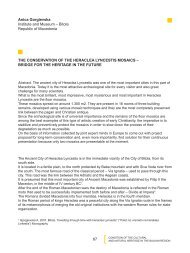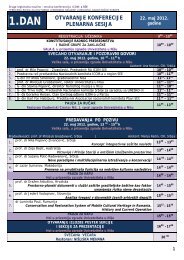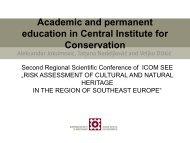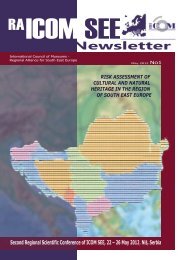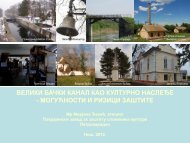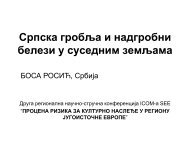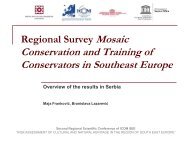Jana Šubic Prislan Nova Gorica Museum Slovenia THE ... - ICOM-SEE
Jana Šubic Prislan Nova Gorica Museum Slovenia THE ... - ICOM-SEE
Jana Šubic Prislan Nova Gorica Museum Slovenia THE ... - ICOM-SEE
Create successful ePaper yourself
Turn your PDF publications into a flip-book with our unique Google optimized e-Paper software.
Irena Porekar Kacafura, Eva Iles and Igor Ravbar, while for short periods we were joined also byTamara Trček Pečak, Alojz Umek and Ivo Nemec. Immediately in the first year we “discussed theemployment and training issues affecting museum conservators and the preparations forpublishing our internal gazette, in which contributions on conservation work and the profession ingeneral would appear, and which would serve as a source of information in the preparation for theprofessional examination”. This is what is said in my reports. I will now go on to describe how werealised all these plans, even though it took us nearly 20 years. All along we worked according to abroad, comprehensive programme, drawn up within the MAS every year, which we tried to makehighly professional, especially in contact with other institutions involved in the protection of culturalheritage in <strong>Slovenia</strong> and abroad. Realisation depended on the finances received from the Ministryof Culture, in connection with which we often felt unjustly overlooked and were consequently oftendissatisfied and demotivated.<strong>Museum</strong> conservators and restorers need a great deal of knowledge and many skills in order to beable to do their work well, but for a long time it seemed that no one appreciated this. We feltmarginalised, ignored and unjustly discriminated against, until we realised that often we ourselveswere not aware of the importance of our role in the process of the protection and preservation ofheritage and that we had to be more proactive. We thought that it was of key importance to appearin public, introduce ourselves, draw attention to our work, get a higher profile and become moreconvincing, thus slowly fulfilling our goals. It was not possible for us to appear as individuals or asa narrow segment of the conservation and restoration activities in <strong>Slovenia</strong>, and thus all of usworking in related institutions and associations sought each other out and united in jointcampaigns. The current dynamic state within the profession is the result of the strivings of all thosewho cared about what tomorrow would bring. We stuck to the principle that initiatives coming fromdifferent directions should be widely supported and this enabled us to successfully carry outnumerous joint projects by combining our financial resources. Although only some of us had theodd sleepless night, all of us throughout <strong>Slovenia</strong> were active: in addition to the conservation andrestoration section within the MAS and the National <strong>Museum</strong> there was also the SloveneRestoration Society, the Restoration Centre, the Academy of Fine Arts – Restoration Department,the Centre for Restoration within the Archive of the Republic of <strong>Slovenia</strong> and individuals inmuseums and galleries.Behind the scenes we took care mainly of the development of the profession, as without firmfoundations and working to a high professional standard all the rest would be unviable. One of thefirst activities that began in 1991 was the joint procurement of equipment and materials for all themuseum conservation and restoration workshops, which was financed by the Ministry of Culture.The collegiate body carefully selected and ordered suitable equipment, a great deal of which hadto come from abroad. Thus most of the workshops over a period of 10 years received micromotors,vacuum driers, digital scales, micro-sanders, polishing machines, the necessaryequipment for sulphite procedures, special lights, various small instruments, chemicals and variousconsumables. When financial support slowly began to dwindle, in order to get a better overview ofthe conditions in conservation and restoration workshops, we drew up a questionnaire that wassent out in 2001 to 26 museums with conservation workshops or museums in which conservationand restoration activities took place. We ascertained what sort of premises they had, how wellequipped they were, what materials they were capable of working on and, above all, what weretheir as yet unfulfilled needs. Even then, some workshops were still very badly equipped andbarely differed from caretakers’ storerooms. I also remember that we asked them what theirexpectations were from this joint project and one of the answers was: “Miracles.” Today I dare saythat we succeeded at least partly and provided an equal supply of basic equipment for all, as well324[CONDITION OF <strong>THE</strong> CULTURALAND NATURAL HERITAGE IN <strong>THE</strong> BALKAN REGION


